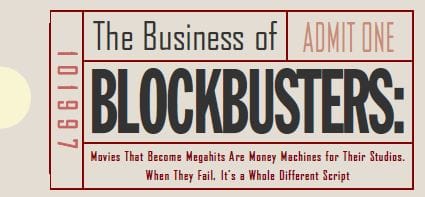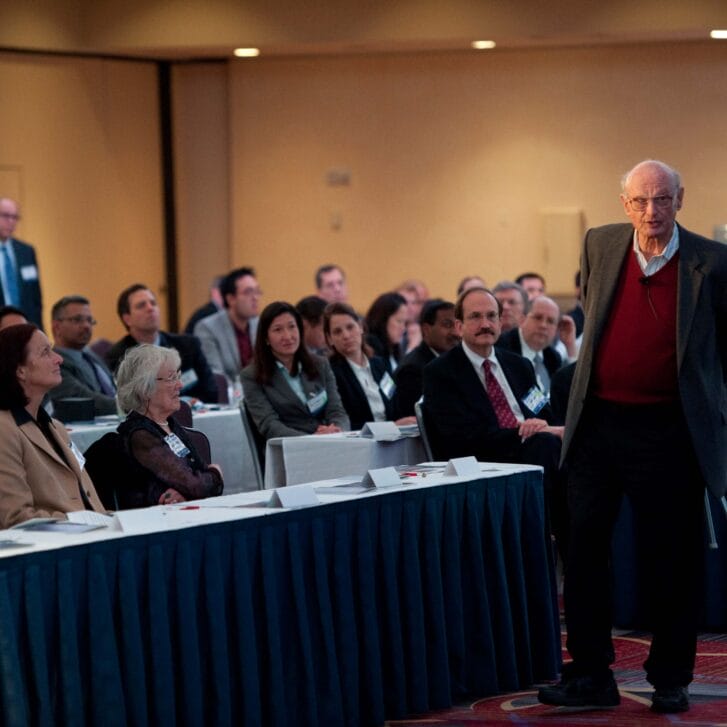
An ad last July for Ulee’s Gold, the Peter Fonda movie about a beekeeper trying to raise his grandchildren in a small town in Florida, described the film as “an antidote to the mindless mayhem of the summer blockbusters and busts … In its own quiet, intelligent manner, the movie will blow you away.”
The promoters of Ulee’s Gold were clearly banking on movie goers’ dissatisfaction with one of summertime’s most sacred rituals – the parade of blockbuster movies that glut the screens of America’s multiplexes from May 10 through Labor Day (Hollywood’s definition of summer): blockbuster, as in male-oriented action movies, heavy on special effects and light on plot; as in the megabucks that studios are spending – some say recklessly – on producing and promoting what they desperately hope will be hit shows.
The stakes for the studios are enormous. A hit movie is like a multi-million dollar ATM – churning out revenues from U.S. audiences, international audiences, video rentals, video games, licensing fees, merchandising fees, restaurant tie-ins, theme parks, soundtracks and so forth. Everyone with a cut of the action – from the studios and theaters to the actors and directors – stand to reap huge rewards. Conversely, if a film tanks, the studio is hung out to dry, 100 percent responsible for the losses which can also be in the tens of millions.
It’s a risky business that gets more volatile each year. This summer, studios released a record number of blockbuster films – at least 10 – with budgets of $100 million or more. Studios that spend millions on production costs justify those expenditures by spending additional millions on marketing.
Indeed, average marketing costs alone are more than $17 million per film (with a few movies in the $25 to $30 million range) all in an effort to create that important pre-release buzz that can make or break a movie. Between 1980 and 1996, according to industry sources, the average cost of producing and marketing a Hollywood film rose from $13.7 million to $59.7 million. The figures for 1997 will be higher (the oft-delayed $200 million-plus Titanic alone will raise the average.)
In this pressure-cooker atmosphere, the boiling point is opening weekend: movies that do well continue to get promoted. Those that don’t are shoved aside by the next blockbuster hovering just around the corner.
Then there’s the question of public taste. While the film business is financially risky, it’s also fickle. Audiences that gloried in special effects movies one summer may, the next year, start demanding better plots and more character development. Right about now, for example, some are wondering if the special effects genre, for one, may simply be wearing itself out.
As Stanley R. Jaffe, W’62, president of Jaffilms, a feature film production company in New York, puts it: “Just how many exploding buildings can you look at?”
Blockbusters I: The Bright Side
On or about July 2, once it was clear that Men in Black – a $90 million science fiction-adventure comedy – was going to be a blockbuster, stories about the movie’s studio (Columbia Pictures, part of Sony), its stars (Tommy Lee Jones and Will Smith) and director (Barry Sonnenfeld) appeared everywhere. Opening on 5,000 screens in 3,000 theaters around the U.S., Men In Black grossed $130 million during its first week. (By contrast, Disney’s Con Air, considered a successful movie in its own right, brought in $90 million in the first six weeks.)
A huge hit. But blockbusters don’t necessarily have to be megahits to justify their existence, says Michael H. Mendelsohn, W’84, who owns a production company called Patriot Pictures (a partner and financier of the hit Harrison Ford movie Air Force One) and is entertainment finance portfolio manager/adviser to Banque Paribas. Take Warner Bros.’ Batman & Robin, the fourth of the Batman series that opened last June and – despite costs estimated at between $100 million and $160 million – wasn’t quite the megahit that observers had predicted.
But look at it this way, Mendelsohn says. “If Batman does $100 million in the U.S., that will return $50 million to the studio [theaters take the other $50 million], plus money from videos, international sales and licensing. That could be another $250 to $300 million in revenues. Who cares if it cost $100 million to make…
“People mock these big budget movies but a lot of their criticism is misplaced,” Mendelsohn adds. “Will all of them work? No. If a $100 million movie only takes in $70 million, you lose $30 million, not a big deal for major studios. But if it’s a blockbuster and brings in $500 million, that more than takes care of any problems.”
In one sense, the economics of the film industry make blockbusters a strategic necessity. Hits become valuable franchises that collect revenues from multiple sources, help support a studio’s ongoing operations and also allow studios the opportunity to branch out and experiment with other types of films. Last summer’s Independence Day has made more than $1 billion for Twentieth Century Fox in worldwide ticket sales, merchandise tie-ins and other ancillary revenues. This summer’s The Lost World: Jurassic Park had grossed $227 million for Universal by Labor Day.
Nicholas Wodtke, WG’95, who was senior manager of motion picture finance and corporate development at Sony Pictures before moving to Singapore in May to help Sony launch an action adventure television channel, agrees that blockbusters make economic sense in part because of “the prestige involved. Blockbusters are like a flagship for the studio, and they help support a lot of lesser products as well,” notes Wodtke, who prepared financial analyses for movies like Jumanji, Jerry Maguire, My Best Friend’s Wedding and the upcoming summer 1998 release Godzilla. “When you have a flagship blockbuster you might be able to secure a lot of screens for your other movies too.” Jerry Maguire, he adds, “was a blockbuster in that it earned more than $150 million in domestic box office receipts, but it was also an exception to the rule. It was a romantic comedy and its theme was football,” hardly the usual stuff of which blockbusters are made.
Foreign sales are a vital part of the blockbuster equation. “Studios will tell you not to go by how well their films do in the domestic market,” notes Theodore C. Pedas, WG’54, president of Circle Management Company in Washington D.C. who has produced such films as Barton Fink, Miller’s Crossing, Blood Simple and Raising Arizona, “because they know they can recoup a lot of their expenses internationally.” Daylight, a Sylvester Stallone movie that cost MCA/Universal $70 million to produce, “did less than $50 million in the States, but video was another $20 million and foreign sales another $175 million,” notes Mendelsohn. (It helps that foreign audiences haven’t yet lost their appetite for special effects extravaganzas or Rambo-type films.)
Sushil Tyagi, WG’96, a consultant in Price Waterhouse’s strategy consulting group in Los Angeles who works mainly with media and entertainment clients, sees two different strategies when it comes to the search for successful blockbusters. The first is for studios to make a large number of movies and hope that one will succeed. “That one success will pay for the others,” says Tyagi. “If the buzz in the business is that one of the movies looks like it will be a hit, then the studio will start putting more and more money into marketing it, which leads to further exaggeration of the cost.”
The wiser strategy is to cut back on the number of movies. The logic here, Tyagi says, “is that too many films are coming out too close together and therefore don’t give each other any time to generate money. Studios aren’t saying they will stop trying to produce blockbusters. They are saying they will make fewer of them, plan them more carefully, do a better job of timing their releases and possibly co-finance with another studio to share risks and rewards.”
Part of that strategy, says Tyagi, includes the decision not to get the best, highest-priced talent, “but to look instead at the elements that make a hit, such as special effects, and then spend the money there. It’s a reallocation rather than a reduction of costs.”
Blockbusters II: The Dark Side
Stanley Jaffe, who has produced such hits as Kramer Vs.Kramer, Fatal Attraction, Bad News Bears and Goodbye Columbus during a 30-year career in the film business, sums up the recent blockbuster phenomenon as “a disaster for the industry.”
To begin with, he notes, “it’s an extremely risky financial strategy, not so much because of what these pictures gross as what they net.” Once a studio pays production costs, advertising costs and distribution costs, and once the directors/producers and/or stars take their percentage from the gross, “you would be surprised at how many of these big pictures either don’t make much money or lose it.”
In many cases involving recent blockbusters, notes Wendy Finerman, W’82, who produced the Oscar-winning hit film Forrest Gump in 1994 and now runs her own production company, “the costs, including promotional expenses, can be astronomical. And there is also the cost of the use of the studio’s money, which is something people don’t always factor in. Meanwhile, a lot of talent also has a piece of the movie … The return on investment for the studio might not be that huge.”
Studios, Jaffe adds, have become “dependent on the big title, which has raised the stakes exponentially. Nobody in the industry sneezes if a picture costs $100 million. But if General Motors had a $100 million R&D project that didn’t work out, the company would be embarrassed. In our business it’s just on to the next picture.”
Wodtke, while he sees blockbusters as generally good economic strategy, also speaks of the escalating risks involved in their production. “Those risks are getting bigger every day because so much more money is being spent on advertising, a big part of which is getting prime time TV spots. Everyone is trying to chase after a little bit of ad time. Meanwhile on the production side the costs of talent and special effects are going through the roof. It’s all a gamble in which you are no longer putting $100 on the table, you are putting $1,000.”
Then there is the cannibalization factor. It’s not only that studios are spending enormous amounts of money encouraging viewers to see their pictures, it’s also that wannabe blockbusters are now being released every two to three weeks, rather than every five to six.
“There were too many big movies last summer opening one after the other,” notes Paul Zaentz, W’72, a producer in the Saul Zaentz Film Center which had such hits as The English Patient, Amadeus and One Flew Over the Cuckoo’s Nest. “It doesn’t give them much of a chance. These days if a film is not a success the first weekend, that’s the end.” With so many summer movies out there, adds Mendelsohn, “studios only have one or two or three weeks to draw big crowds before two more huge blockbusters are rolled out.”
Movies, notes Finerman, “are chosen for development for many reasons. First and foremost is how commercial the idea or project appears. The second is whether the material will attract talent, meaning a director and actors/actresses. However, in recent years, movies that were expected to be blockbusters didn’t live up to their expectations and offbeat films that people didn’t think would be hits – like The English Patient and Pulp Fiction – were, in fact, major hits. A lot of times it’s the smaller movies that can be more financially successful and give a greater return to the studio than the blockbuster.
“The most important fact to keep in mind about this industry,” adds Finerman, whose movie Fairy Tale … A True Story is being released this fall, “is that nobody knows for sure what will be successful.”
Independents’ Day
“The English Patient was a huge hit,” says Zaentz, “because there are people out there who want to see a movie that makes them think, that is built on interesting characters and good acting, and that does not have the Hollywood happy ending. But we had to fight the studios to get it made the way we wanted.” [The movie, initially under Twentieth Century Fox, was financed and distributed instead by Miramax, which has since been bought by Disney.]
In fact, four of the five pictures nominated for best picture at last spring’s Academy Awards – The English Patient, Shine, Secrets & Lies and Fargo – were made by independent producers. One might be tempted to conclude that the smaller, independent filmmakers – and “art house” films – are alive and well and clearly a match for the action-oriented, special-effects movie genre.
Yes and no. “There are producers and directors who will make small films, and actors who will give up big money to do roles they believe in,” notes Zaentz, whose next movie will be based on Lies of the Night, a book that takes place in the mid 19th century in a dungeon in Sicily. “But as far as single companies making small films, it’s very difficult. I don’t think there are independent companies but there are independent film makers. The Coen brothers [Ethan and Joel, who wrote and directed Raising Arizona, Fargo and Blood Simple, among others] are at the top of the list.”
Indeed, what some see as a resurgence in independent and art house movies is evidenced by both the number and quality of recent releases – such as Sling Blade, Swingers, Chasing Amy and Brothers McMullen – and the fact that some of the major studios have started or acquired independent arms. Disney owns Miramax; Universal – where Kevin Misher, W’87, is executive vice president of Universal Pictures Production – has a majority stake in October Films; Sony has Sony Classics, and New Line is owned by Turner which is owned by Time-Warner – where Lorenzo di Bonaventura, WG’86, is co-president of production for Warner Bros. In most cases, the consensus is that these independent arms are truly independent, able to retain their artistic autonomy but also able to take advantage of their studios’ distribution systems.
There is clearly an audience for art house movies, notes Mendelsohn, whose co-production credits also include Box of Moonlight released in August, One Tough Cop to be released this winter, and such previous films as The Madness of King George, Reservoir Dogs, Nobody’s Fool and My Life, among others. “That’s why we continue to finance them. Women are tired of hardware action, killing aliens, male testosterone-based pictures. There is counterprogramming going on – i.e. more comedies, romantic comedies, epic love stories and so forth.”
Provided, of course, that people have the time to see them. “It all comes down to marketing,” says Tyagi. “Some movies are advertised through national networks TV buys to such a degree that we are made to feel it’s un-American not to see the film … If a good creative film that is only niche-marketed opened on the same weekend as a broadly promoted one, it could die.”
It’s important to remember that corporations have different profit motivations than independents, Mendelsohn notes. “If I make a movie for $2 million and sell it for $5 million, that is significant profit for me. For someone like Disney, $3 million doesn’t dent their bottom line … Their emphasis is clearly going to be on pictures that make $50 million – $100 million and have an evergreen value in the film library. If I hit a single or double, that’s good for me. I don’t have to hit a homerun.”
“Studios want to adopt a high-low strategy,” adds Wodtke. “They want the blockbuster and also the lower budget films … There is a different market for each. And the rule of thumb is that any hit – whether it’s a blockbuster or an art house film – is good for business in general because it promotes the movie experience overall.”
In fact, it’s the mid-range movies – those costing between $25 million and $40 million to produce – that tend not to be made. “The question is, if you think the movie is going to have very broad appeal and be a hit, why aren’t you spending $100 million on it?” asks Tyagi. Conversely, if it is a “niche story” with more narrowly-defined appeal, “why spend $25 million making it? Why not spend $1 million to $3 million? In any case, don’t be in the middle of the road. Either go for the low-cost game or don’t.”
Mendelsohn makes another point. “Mid-sized movies are difficult to make because of the cost of talent. When a Tom Cruise or Harrison Ford or Sylvester Stallone costs $20 million, and a production involving special effects might be anywhere from $30 million to $50 million, plus your print and advertising costs, then already you have moved beyond the $25 million to $40 million film. That’s why you see fewer studio pictures in that range.”
Even though marketing independent films is more difficult these days because of the consolidation of the smaller art houses, more independent films are being made than ever before, says Pedas. “Fifteen years ago when you had an independent film you would play at certain houses and then be finished with it. Now you have a lot of suburban theaters doing very well with these films,” some of which, Pedas adds, are grossing huge sums at the box office. “If you have a really good story to tell,” Pedas says, “you will find the financing.”
“I’ve never had a picture that anybody thought was going to be a blockbuster and yet I have had some pictures that were among the most successful ever,” notes Jaffe, who is now making a movie for Tristar based on Madeline, the sprightly French heroine of a series of children’s books. “There is an audience out there for good scripts and unusual ideas.”
THE BOOK BUSINESS: A WHOLE DIFFERENT CHALLENGE
Consider them the blockbuster stars of the publishing business, authors like Michael Crichton, Dean Koontz, Danielle Steel, Anne Rice, John Grisham, Tom Clancy, Judith Krantz, John Le Carré and others whose books are immediate best-sellers and whose next book is eagerly awaited by a large and loyal following.
But publishers, while always on the alert for best-selling authors with legs (i.e. writers who can produce with reassuring frequency), face different challenges than the makers of blockbuster movies.
“Studios develop a handful of movies per year whereas our industry develops 50,000 titles,” notes Alberto Vitale, WG’59, chairman, president and CEO of Random House Inc., the largest trade publisher in the U.S. “And the investment in a movie is infinitely greater than the investment in a book.”
Also, whereas a blockbuster movie like Independence Day or Jurassic Park can bring studios millions of dollars in box office receipts and ancillary revenues, best-sellers in the publishing industry aren’t quite so lucrative.
“Publishers can’t live on blockbusters alone because they are unpredictable,” says Vitale. “You can’t plan for them unless the books are from an established major author. Yes, you need best-sellers but you also need to have a variety – new authors, fiction writers, non-fiction writers and so forth … The New York Times best-seller list has 30 books on it every week, but for many of those weeks the books are the same. I would estimate there are only 300 to 500 best-selling books per year.”
 “All books contribute to the bottom line,” adds Harold Clarke, WG’90, president of Random House Juvenile Division, which publishes about 350 books a year under three major imprints – Random House, Knopf Books for Young Readers and Crown Books for Young Readers. “You can’t come in with a machete and say you are going to cut out the non-performers and suddenly be more profitable. The economics of publishing are such that you need all the books.”
“All books contribute to the bottom line,” adds Harold Clarke, WG’90, president of Random House Juvenile Division, which publishes about 350 books a year under three major imprints – Random House, Knopf Books for Young Readers and Crown Books for Young Readers. “You can’t come in with a machete and say you are going to cut out the non-performers and suddenly be more profitable. The economics of publishing are such that you need all the books.”
Every year, Clarke says, “a publisher completely reinvents itself. It’s not like you have finally created the perfect sugar free shredded wheat and now it’s done. In publishing you are recreating every single book.
“And because it’s a talent business, the cumulative benefit of that creativity usually accrues to the author. The author owns the brand.”
Which means the author can always decide to jump publishers depending on who offers the biggest advance and best deal. “The only brands publishers have are authors,” notes Philip Grabfield, WG’87, a consultant with the Marketing Corporation of America who spent eight years with Kraft Foods before being hired at Bantam Doubleday Dell in New York to “bring the packaged goods marketing philosophy and methodology into publishing. The experiment didn’t work because the framework wasn’t right. Publishers are reluctant to put a lot of money into marketing their brands … They feel it’s risky to build equity behind a specific brand (author) because the stronger you make an author the easier it is for him or her to demand bigger advances.”
Despite the search for, and cost of, best sellers, no one seems to feel that unknown authors are being denied opportunities to publish their work. “If the publishing business was dominated by only large publishing companies, then perhaps new authors would have a hard time getting contracts,” says Clarke, who adds that with children’s books the process of finding authors and nurturing them over long periods of time is still the operating approach of most quality publishers. “But if you look at the landscape and note how many books are published each year by non-giants, then you would see that there is no lack of publishing activity … Talk to a retailer with 100,000 books in his store and ask him how many different publishing companies he works with. You would be astounded by the number.”
“The American public is not being denied good books,” adds Vitale. “You have to look at the whole industry. In addition to the large publishing houses, there are always the smaller presses.” And if they are bought by big companies? “New ones will always start up,” he says.

























